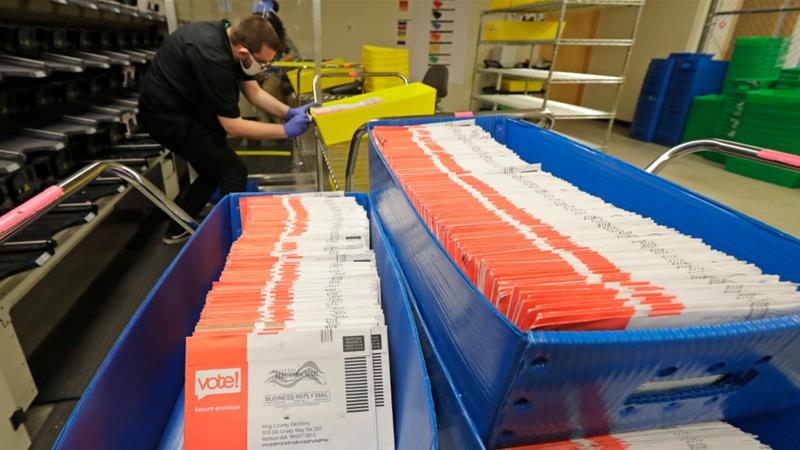
The number of Americans voting by mail in the national election on November 3 is expected to nearly double due to coronavirus pandemic, which has hit the United States harder than any other country in terms of the number of deaths and cases.
But election experts see little reason to expect an increase in ballot fraud, despite President Donald Trump's repeated claims.
Voting by mail is not new in the US - nearly one in four voters cast 2016 presidential ballots that way.
Routine methods and the decentralised nature of US elections make it very hard to interfere with mailed ballots, experts say.
And while mail-in balloting does have its drawbacks, it can help minimise the long lines at polling sites, faulty voting machines and COVID-19-induced staffing shortages that have already hindered some US elections this year.
How secure is it?Election experts say it would be nearly impossible for foreign actors to disrupt an election by mailing out fake ballots, a scenario floated by Attorney General William Barr.
For one thing, voters will not just be selecting a president: they might be choosing candidates for city council, school board and weighing in on ballot initiatives. That can require hundreds of different ballot designs in a single county and the US has more than 3,000 counties.
US election: Democrats call on Postal Service leaders to testifyBallots are not counted if they are not printed on the proper type of paper and do not include specific technical markings.
States also require voters to sign the outside of their envelope, which they match to a signature on file.
Some 29 states and the District of Columbia allow voters to track their ballots to ensure they are received, according to the National Conference of State Legislatures.
Fourteen states and DC also allow voters to return their ballots by hand if they do not trust the mail.
Those envelopes are typically opened by a different group of workers than those who scan the ballots. Outside observers are allowed to monitor the process to ensure voter privacy.
Is fraud a problem?As with other forms of voting, documented cases of mail-ballot fraud are extremely rare.
The conservative Heritage Foundation, which has warned of the risks of mail voting, found 14 cases of attempted mail fraud out of roughly 15.5 million ballots cast in Oregon since the state started conducting elections by mail in 1998.
The most prominent cases of mail fraud have involved campaigns, not voters.
North Carolina invalidated the results of a 2018 congressional election after state officials found that a Republican campaign operative had orchestrated a ballot fraud scheme.
Experts say those scenarios can be minimised by nixing requirements - currently in place in 11 states - which instruct voters to get at least one witness to sign their return envelopes. At least two of those states have created special exemptions for voters who cite the coronavirus as the reason for requesting the mail-in ballot.
"All of these policies remove the need to hand over your ballot to someone you don't know," said Tammy Patrick, a former election official in Maricopa County, Arizona.
Do universal mail-in ballots change anything?The Trump administration, in recent days, has focused its criticism of mail-in ballots more specifically on states that have so-called universal mail-in ballot systems.
These states send ballots to all registered voters, as opposed to only those registered voters who request them.
With Universal Mail-In Voting (not Absentee Voting, which is good), 2020 will be the most INACCURATE & FRAUDULENT Election in history. It will be a great embarrassment to the USA. Delay the Election until people can properly, securely and safely vote???
— Donald J. Trump (@realDonaldTrump) July 30, 2020
https://twitter.com/realDonaldTrump/status/1288818160389558273?ref_src=twsrc%5Etfw
Before the coronavirus pandemic, five states - Washington, Utah, Oregon, Hawaii and Colorado - had previously sent mail-in ballots to all registered voters and planned to do so in 2020.
California, Nevada, Vermont and New Jersey have since adopted the approach in light of the pandemic.
The White House, which has sued Nevada, notably the only battleground state currently planning to send ballots to all registered voters, over the policy has said that more widely distributed ballots increase the chances of fraud, especially in instances where voters no longer live at the address at which they registered to vote.
However, there has been no evidence of increased fraud in states that had already been sending mail-in ballots to all registered voters.
Democrats have argued that fraud under all systems of mail-in voting generally remains easy to detect and investigate, with Senator Corey Booker noting, according to Politico, "you literally have a paper trail".
Does mail-in voting help voter turnout?Turnout rates tend to be higher in states that conduct elections by mail.
A Stanford University study found that participation increased by roughly two percentage points in three states that rolled out universal voting by mail from 1996 to 2018. It had no effect on partisan outcome and did not appear to give an advantage to any particular racial, economic or age group.
When folks in CO #VoteAtHome🗳 every ballot goes through a rigorous security process ensuring it's safe & secure including:
✅Signature verification
✅Secure ballot design
✅Vote tabulation overseen by judges
✅Checking their work
Read more here⬇️https://t.co/P4fAHu5tHa
— Vote At Home (@voteathome) August 16, 2020
In Colorado, 77 percent of voting-age citizens cast ballots in the 2016 presidential election, the highest figure in the country, according to the US Election Assistance Commission. In Oregon, that figure was 72 percent and in Washington it was 68 percent, well above the national average of 63 percent.
Are there barriers?Like any other voting method, mail balloting has its drawbacks.
States rejected 1 percent of returned ballots in 2016 for arriving too late, missing signatures or other problems, according to EAC figures - though that figure was as high as 5 percent in some states.
SOURCE: Al Jazeera and news agencies





